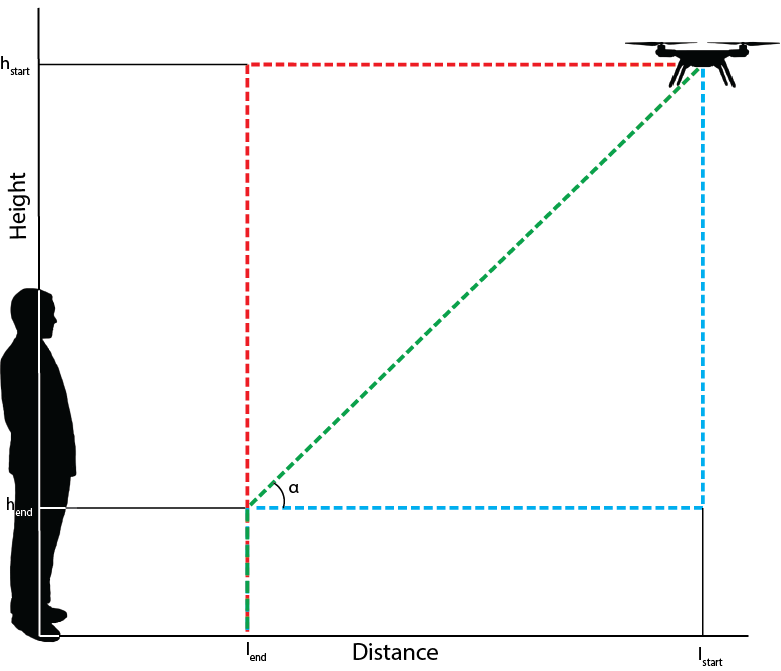PRE2015 3 Groep2 week4: Difference between revisions
| Line 7: | Line 7: | ||
The first two variables are technical constraints and thus attached to the approach. Variables 3 and 4 are coming from 2 experiments where values are computed for the optimal landing distance (relative to the user) and for a preferred flying path when approaching the user. | The first two variables are technical constraints and thus attached to the approach. Variables 3 and 4 are coming from 2 experiments where values are computed for the optimal landing distance (relative to the user) and for a preferred flying path when approaching the user. | ||
== | == Flying speed == | ||
Average walking speed is researched to be 1.4 m/s second<ref>British Heart Foundation, [https://www.bhf.org.uk/get-involved/events/training-zone/walking-training-zone/walking-faqs Walks and treks FAQs]</ref>. For safety and the accuracy of the | Average walking speed for a human is researched to be 1.4 m/s second<ref>British Heart Foundation, [https://www.bhf.org.uk/get-involved/events/training-zone/walking-training-zone/walking-faqs Walks and treks FAQs]</ref>. For safety and the accuracy of the experiments however, the speed of the drone has been set slightly lower; v = 1 m/s. | ||
== | == Approaching height == | ||
For the | For the approaching height of the experiments, a height of 1 meter is chosen. This because of the following: Lower heights would result in issues with obstacle avoidance, whereas higher heights might pose danger for the user. Eye-height of possible users might vary from 1.50 m to 2.20 m<ref>Variation in Eye height, [https://www.google.nl/url?sa=t&rct=j&q=&esrc=s&source=web&cd=1&ved=0ahUKEwjax4qc4JzLAhXGWRoKHUm6AsMQFggcMAA&url=https%3A%2F%2Fwww.ergotron.com%2FPortals%2F0%2Fliterature%2FwhitePapers%2Fenglish%2Fergonomics_arms_data.pdf&usg=AFQjCNHazybqgJzdcCaCC3QYDYyNzKCY_g&sig2=-n79_9WIYPxCOTvAjGgIaA&bvm=bv.115339255,d.bGs&cad=rja Ergonomics Data & Mounting Heights]</ref>, making this domain unsuitable for flight. Given the accuracy of the drone for keeping the height another 0.5 meter is implemented as safety feature. | ||
== Experiment 1: Landing distance == | == Experiment 1: Landing distance == | ||
Revision as of 16:41, 29 February 2016
Approaching Users
Multiple factors can play a role for users to feel safe and comfortable with the drone approaching them. Little research has been done regarding approaching people in a user friendly way, as can be seen in the chapter Research from week 3. In order to be able to construct constrains and preferences for the approaching, four variables have been devised:
- Variable 1: Flying speed
- Variable 2: Approaching height
- Variable 3: Landing distance
- Variable 4: Flying path
The first two variables are technical constraints and thus attached to the approach. Variables 3 and 4 are coming from 2 experiments where values are computed for the optimal landing distance (relative to the user) and for a preferred flying path when approaching the user.
Flying speed
Average walking speed for a human is researched to be 1.4 m/s second[1]. For safety and the accuracy of the experiments however, the speed of the drone has been set slightly lower; v = 1 m/s.
Approaching height
For the approaching height of the experiments, a height of 1 meter is chosen. This because of the following: Lower heights would result in issues with obstacle avoidance, whereas higher heights might pose danger for the user. Eye-height of possible users might vary from 1.50 m to 2.20 m[2], making this domain unsuitable for flight. Given the accuracy of the drone for keeping the height another 0.5 meter is implemented as safety feature.
Experiment 1: Landing distance
Have the test subject stand on a given spot (l=0). The distances 1, 2, 3…10 meters are marked with masking tape (distance to test subject). The drone will start at a distance of 10 meters (= lstart) and approach the person at a steady speed of approximately v = 1 m/s. It does so at a height of h = 1 meter. Whenever the test subject feels like the current distance between him and the drone is the most comfortable distance to land, the test subject will give off a sign and the drone will be given the order to land (lend).
Experiment 2: Way flying

A distinction is made between three different situations. For a description of these situation see the list below and figure 1.
- Situation A
- The drone flies horizontally to a certain distance lend then the drone land vertically.
- Situation B
- The drone flies diagonally to a certain point lend en hend. Then the drone lands vertically.
- Situation C
- The drones lowers itself vertically to a certain height hend. It then flies horizontally to a certain distance lend before it lands vertically on the ground.
References
- ↑ British Heart Foundation, Walks and treks FAQs
- ↑ Variation in Eye height, Ergonomics Data & Mounting Heights